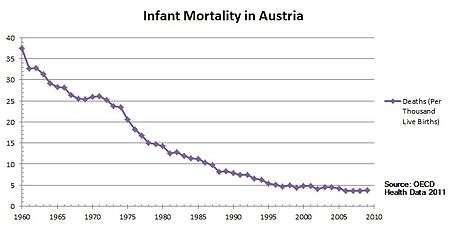Healthcare in Austria
.png)
The nation of Austria has a two-tier health care system in which virtually all individuals receive publicly funded care, but they also have the option to purchase supplementary private health insurance. Some individuals choose to completely pay for their care privately.[1]
Details

Healthcare in Austria is universal for residents of Austria as well as those from other EU countries.[2] Students from an EU/EEA country or Switzerland who are in possession of a valid national health insurance in their home country merely need the European Health Insurance Card.[3] So called self-insured students have to pay an insurance fee of EUR 52.68 per month.[3]
Individuals become automatically insured when employed, receiving unemployment benefits, on pensions, or works for government. Family members who are dependent are also entitled to healthcare up until adulthood, or upon finishing education.[4] Care involving private insurance plans (sometimes referred to as "comfort class" care) can include more flexible visiting hours, occupying a private room, and receiving care from a private doctor.[1] By 2008 the economic crisis, caused Austria to fall into a deep recession, during which the out of pocket payments for healthcare increased to being 28% of the source of the health expenditures.[5] By 2010 Austria's public spending has decreased overall but healthcare spending to 15.5%, compared to 13.9% it was 15 years earlier, this shows just how vital the healthcare sector is in Austria.[6]
Care involving private insurance plans (sometimes referred to as "comfort class" care) can include more flexible visiting hours, occupying a private room, and receiving care from a private doctor.[1]
International comparisons
Austria's health care system was given 9th place by the World Health Organization (WHO) in their mid-2000s (decade) international ranking.[1]
The city of Vienna has been listed as 1st in quality of living (which includes a variety of social services) by the Mercer Consultants.[1]
In a sample of 13 developed countries Austria was 5th in its population weighted usage of medication in 14 classes in 2009 and fourth 2013. The drugs studied were selected on the basis that the conditions treated had high incidence, prevalence and/or mortality, caused significant long-term morbidity and incurred high levels of expenditure and significant developments in prevention or treatment had been made in the last 10 years. The study noted considerable difficulties in cross border comparison of medication use.[7]
It was placed 12th in Europe by the Euro health consumer index in 2015. The fact that abortion is not carried out in the public healthcare system reduced its rank.[8]
History

Austria’s health care system was developed alongside other social welfare programs by the Social Democratic Party of Austria in Vienna (during its classical 'Red Vienna' period) initially.[9]
Austria's health care began primarily in 1956 with the "Allgemeines Sozialversicherungsgesetz" better referred to as the General Social Insurance Law or ASVG, which mandated that healthcare is a right.[10] Individuals become eligible, and automatically registered for healthcare, upon employment.[11] The individual get included into the insurance fund known as Krankenkasse, which results in you receiving an insurance card that covers not only the healthcare, but pensions, and unemployment as well. The level of coverage rapidly grew since 1955-1956 ratification of the General Social Insurance Law, and by 1980 it included unrestricted hospital care, and preventive check-up.[6]

Structure
Austria's health programs are funded by the sickness insurance fund known as the Krankenkasse, which in 2013 took 11.0% of the GDP, which was above the average of the E.U average of 7.8% of GDP.[12] Austria's healthcare system is decentralized, and operates with a system similar to United States federalism. Each of the nine provinces and the federal government of Austria have legal limitation and roles in their healthcare system. Federal Ministry of Labor and Social Affairs is the federal aspect, it's role is to develop the framework for the services that are offered, and handle the sickness insurance fund known as the Krankenkasse, which funds Austria's healthcare system. The role of the Provinces is to manage and provide the care as needed.[13] Since Austria's health program covers a vast array of social insurance including but not limited to unemployment insurance, family benefits, accident insurance, the overall bureaucracy is vast. While the Krankenkasse is the primary fund, Austria social protection network actually implemented by 22 smaller funds, 19 of which are purely for sickness and all of which by public law are self-governed in order to insure decentralization.[4]
References
- 1 2 3 4 5 Bondi, Susie (September 2009). "Austrian Health Care". Association of Americans Resident Overseas. Retrieved April 2, 2011. External link in
|publisher=(help) - ↑ The Austrian healthcare system Overview of how it works Accessed: 16 October 2011.
- 1 2 Austrian agency for international mobility and cooperation in education, science and research: National health insurance Retrieved: June 26, 2014.
- ↑ "Expenditure on health care". European Foundation for the Improvement of Living and Working Conditions. 2011.
- 1 2 "Financing" (PDF). European Observatory. 2013.
- ↑ Office of health Economics. "International Comparison of Medicines Usage: Quantitative Analysis" (PDF). Association of the British Pharmaceutical Industry. Retrieved 2 July 2015.
- ↑ "Outcomes in EHCI 2015" (PDF). Health Consumer Powerhouse. 26 January 2016. Retrieved 27 January 2016.
- ↑ Austria. European Observatory on Health Care Systems
- ↑ "The Health care Systems of the Individual Member States" (PDF). EUROPEAN PARLIAMENT. 2000.
- ↑ "Employment, Social Affairs & Inclusion" (PDF). European Commission. 2013.
- ↑ "Austria Health Care & Long-Term Care Systems" (PDF). European Commission. 2016.
- ↑ "The Health care Systems of the Individual Member States" (PDF). European Parliament. 1998.